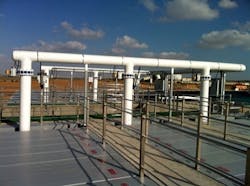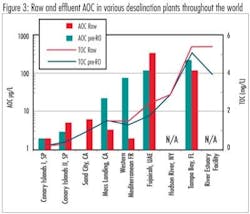Rehabilitating Venturi Flow Primaries Can Lead to Decades of Further Use
By Jeff Smith
Of the many water/wastewater flow metering technologies available, none can match longevity of Venturi flow primaries. Some Venturi flow meters installed in the early 1900s in large urban municipalities have been proven by independent testing to deliver high accuracy even to this day. In fact, Venturi flow primaries are so durable that even when they do show signs of wear, in most cases, their fundamental structures remain intact and functional.
Because of this, managers and engineers for municipal waterworks have found they can save time and money by having flow primaries rehabilitated to full function if they develop internal build-up or galvanic corrosion over time. In many cases, they have determined that rehabilitation makes operational and economic sense, compared to replacing the flow primaries with new meters or alternate technologies.
Venturi flow meters, which have no moving parts, can function reliably and accurately for decades, with some examples in service for more than 100 years. Furthermore, Venturis are independently proven to perform at ± 0.25% accuracy if laboratory flow calibrated, and ±0.5% to ± 1.0% in the field. This is based on bench calibration and dependent on the type of Venturi meter, with modified short form devices at ± 0.5% and classical type devices in the range of ± 1.0%.
Their elegant mechanical design is so fundamentally sound that individual meters can outlast even the most durable material components. However, the design and materials used in Venturi meters have not remained static over the last century, and although the fundamental principles have remained the same, some important updates have made today's technology even more accurate and reliable than past versions.
Materials and design elements which have become obsolete can be responsible for performance degradation of some meters, adding to the age related issues of general wear, for example:
- Annular pressure-averaging rings or chambers, found in classical long and short form models, are prone to sediment accumulation or galvanic corrosion, unlike modern, static-tap designs typical of today's modified short form Venturis;
- Bronze components can oxidize and wear away over time, and also react with dissimilar metals like iron or steel to cause galvanic corrosion;
- Old internal and external protective coatings can erode, especially underground.
The lack of observation ports on older flow primaries also can make it difficult for hydraulic engineers to determine if there is any significant change to the metering cross-sections of the Venturi. This can impinge upon system function, particularly within the inlet high pressure and throat low pressure portions of the meter.
Venturi Rehabilitation
One of the virtues of Venturi flow primaries is their durability and a simple design that lends itself to rehabilitation. When carried out by experts, rehabilitation can return a flow primary to its original functioning parameters and accuracy at a fraction of the cost of replacement, often within only a few days.
Venturi meters can be rehabilitated in the field or in a factory, depending upon the situation and size of the meter. Flanged insert-style meters and meters made of uncommon materials can be restored in most cases. As with any quality meter installation, Venturi suppliers conducting rehabilitation services develop technical specifications to protect their customers and guarantee both quality and scope of service.
One benefit of meter rehabilitation is customization, which maximizes value for each customer. Because of this, rehabilitation procedures are each unique, however, any rehabilitation process will include:
- 1. Meter "audit": Inspection and analysis of the interior and exterior condition of the meter, identifying issues in need of remedy;
- 2. Development of a rehabilitation plan based upon inspection of the meter; determine whether on-site rehabilitation is advisable, or factory rehabilitation is recommended. This plan is submitted to the owners of the meters for approval.
- 3. Updating designs and materials to current standards, including sealing off annular rings in the event they are fully plugged and converting the annular type pressure sensing system to a sealed diaphragm system, replacing outdated or damaged portions of the meter with current technology materials, and optionally placing observation ports at key positions so as to insure full internal inspection of the meter;
- 4. Cleaning and refinishing the unit to restore and upgrade internal and external surfaces with coatings that offer longer life expectancy than the original coatings;
- 5. Measuring the interior geometry to develop a current discharge coefficient (meter factor) and providing updated and certified documentation based on the rehabilitated performance of the meter, thus allowing for accurate calibration of secondary instrumentation, bringing the meter back in line with original operating specifications.
- 6. Ensuring that all environmental standards are met in the operation of the meter and the disposal of materials involved in its restoration.
A Venturi primary flow meter rehabilitation program provides many benefits and advantages over other solutions. The cost of rehabilitation can be significantly less than a new meter, and can conserve original piping and stabilizing structures, as well as the meter itself.
Rehabilitating a Venturi can restore the meter's original operating accuracy and restore or improve its reliability. This is achieved through new flow calculation and calibrations, as well as upgrades in design and materials that bypass former vulnerabilities, such as replacing old materials, plugging annular rings, and upgrading materials. Installation of optional observation ports can also make flow primaries easier to inspect in years to come, and rehabilitation or replacement of rate-of-flow-controllers and secondary equipment ensures that the entire system is optimized.
About the Author: Jeff Smith is National Sales Manager at Primary Flow Signal. He has worked in the instrumentation and process controls market for over 30 years. In 1995, Smith founded Alpha Valve & Controls – a manufacturer's representative firm specializing in flow measurement instrumentation, representing PFS Venturi Flowmeters, as well as magnetic, ultrasonic, open-channel, and Area X velocity flowmeter manufacturers. He joined Primary Flow Signal following the sale of Alpha Valve & Controls in 2007.
More WaterWorld Current Issue Articles
More WaterWorld Archives Issue Articles


